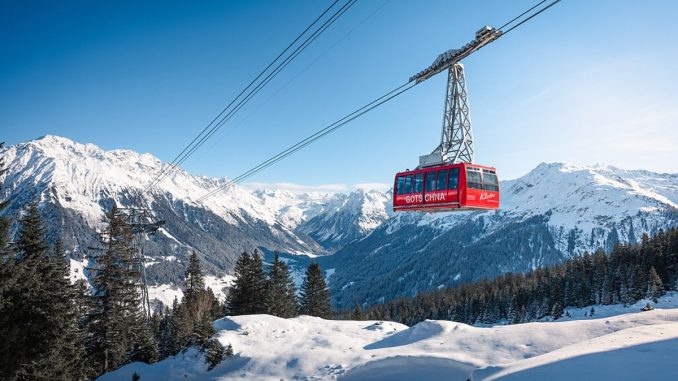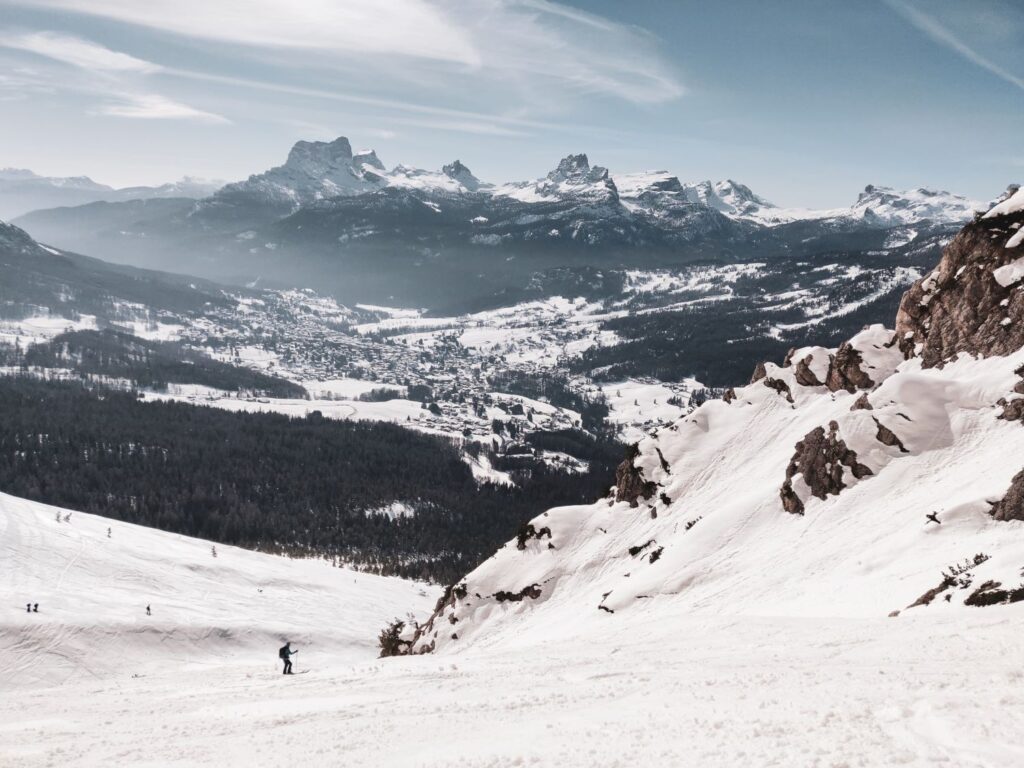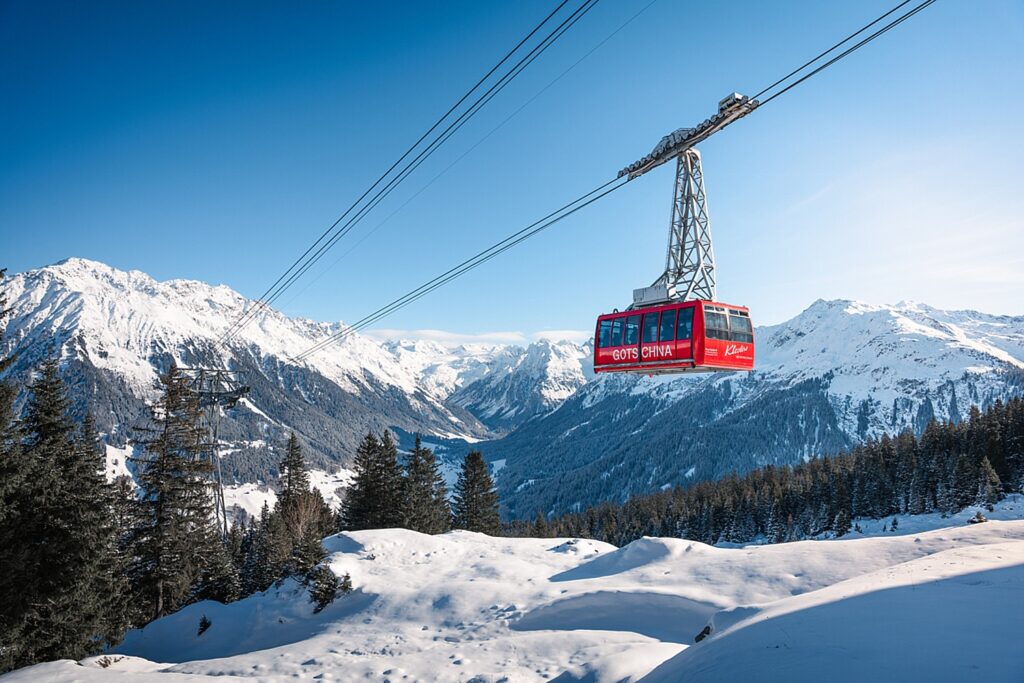
By Karen Rubin, Travel Features Syndicate, goingplacesfarandnear.com
The Best of the Alps, a tourism promotion consortium founded more than 40 years ago, recently came to town to remind American travel writers that this is where skiing began over 100 years ago and that these iconic destinations are still for the most part villages and towns where people live year-round, where tourists come year-round, and where you can be immersed in heritage and traditions as you experience all that the mountains have to offer.
“There is more to skiing than a purpose-built resort,” said, Sammy Salm, CEO of the Best of Alps. “These villages have existed for 100 years, some for more than 300 years, attracting summer travelers. Then, 155 years ago, some hotels decided to stay open in winter.” They built the first motor-driven ski lift, hosted the first Winter Olympics.
These are the most authentic places, he noted. Most of the businesses have been in the same family for generations. There are cultural and sports events throughout the year – some 1,000 in 10 destinations – covering all manner of interests. You enjoy cuisine that reflects the locality – “farm to table” before the expression was a thing.
There are iconic hotels – some five star, some with a century of history but with the modern amenities and technology to suit today’s skiers, even Americans. And while the Alps are regarded as upscale, there are accommodations to meet every budget and style of travel – you can find hostels; cool, trendy boutiques; hotels ideal for families, multi-generational families and women traveling solo. “There is something for every level, age, interest, summer and winter.”
Best of the Alps Span Austria, Switzerland, France and Italy: Chamonix Mont-Blanc, St. Anton Am Arlberg, Crans-Montana, Kitzbuhel, Megeve, Garmisch-Partenkirghen, Lech Zurs am Arlberg, Cortina D’Ampezzo, Courmayeur, and Davos – each manifesting its own charm and authentic style, a strong sense of place, identity. Together, they form the “cradle of skiing.”
“If you like skiing, you will want to go to the Alps at least once,” reflects Cortina’s Maria Alessandra Montuori.

Cortina D’Ampezzo, the “Queen of the Dolomites” in a national park within a UNESCO World Heritage Area, epitomizes charm, glamour and elegance. Today, it is in northern Italy, but for 400 years (until 1900), Cortina was part of Austro-Hungarian Empire, so manifests an Austrian ambiance. There is evidence of ancient Roman settlements, traces of the Barbarians. During its strategic geographic location on one of the crossings through the Alps, Cortina was part of the Republic of Venice and even today is on the Venice Simplon train route from Paris to Venice. The railway arrived in the mid-1800s bringing the first wealthy Anglo-Saxon, German and Russian travelers. Newspaper articles and guidebooks written by pioneering mountaineers soon made Cortina d’Ampezzo known all over the world. Beginning in 1896, Cortina’s “purity of air” made it one of the first tuberculosis retreats. Visitors started playing golf in summer (there are two courses), then skiing. Today, the town of 6,000 inhabitants offers 20,000 guest beds, 85 restaurants and 200 shops.
Set on a plateau 4500 ft. high, Cortina d’Ampezzo, with 6,000 inhabitants, offers skiers breathtaking scenery from an altitude of 1224 to 3248 meters. The resort’s three ski areas are connected by a free bus and offer 120 km of slopes (the longest trail is 10 km),accessed by 35 lifts with snow making. Winter activities also ski mountaineering, sledding in the moonlight after a dinner in a mountain hut, 70 km of Nordic skiing and 100 km of snowshoeing and 50 km of winter hiking. In summer, Cortina offers 400 km of hiking trails, biking on hundreds of kilometres of marked trails amid magnificent Dolomite scenery, mountain climbing, an indoor climbing center, indoor and outdoor tennis; golf, summer ice skating; horse riding, canyoning, and activities families can enjoy together – water park, skate park, zipline.
“’New’ isn’t a new lift, it’s a new way to enjoy mountain,” Montuori tells me. “People can exercise the way they like.”
Seventy years since it was the first Italian venue for the Olympics, in1956, Cortina will host the 2026 Winter Olympics (with Milan), spurring new development and improvements.
The most convenient airports are Venice (there is bus service from Venice Airport), Treviso, and Innsbruck; the train station is Toblach. (cortina.dolomiti.org)
“Discover your true nature” is the motto of Garmisch-Partenkirchen, a multifaceted mountain region at the base of the 2,962 meter high Zugspitze mountain. It features winter sports with 207 km of ski runs (longest is 6.8 km) from a base at 708 meters to 2,962 meters, state-of-the art lifts, snowmaking on four long runs into the valley, backcountry skiing; the legendary ski stadium and ski jump and on Tuesdays and Thursdays, the Bayerische Zugspitzbahn invites ski alpinists to a “Ski Tour Evening.” Also: 28 km of cross-country ski tracks, the famous biathlon and cross-country ski center in Kaltenbrunn (snow-making and flood lights for night-skiing); Visitors’ Biathlon in Kaltenbrunn on Wednesdays); ice skating and curling at the Olympic Ice Sports Center on one of the many natural lakes. The racy 1.6 km run down from the cozy lodge, St.-Martins-Hütte am Grasberg, is an insider tip for bold sledders. Garmisch-Partenkirchen also offers 110 km of groomed winter hiking trails. Special experiences: a torch hike through the Partnachklamm gorge featuring amazing ice and snow formations; a romantic ride in a horse sleigh; guided winter hikes from the Gesundheits-Eck meeting point (book January-March).
In warmer seasons, hiking in the Garmisch-Partenkirchen region offers varied landscapes and breathtaking views of hiking along 300 km (124 miles) of paths (the GaPa tour planner, www.gapa.de/tourenplaner, has detailed route and trail descriptions); you can plan multi-day tour with overnight stays in rustic mountain lodges, or guided hikes ranging from herbal excursions to therapeutic climatic healing hikes. Also rock climbing, mountain biking, kayaking and canoeing, paragliding, hang gliding, tennis, horseback riding, fishing, archery or a ride in a historic horse-drawn carriage, plus 23 golf courses within one hour’s drive.
Garmisch-Partenkirchen, with 10,000 guest beds, 172 restaurants and 450 shops, can be reached by German Rail, Deutsche Bahn (Saturdays ICE connection from Hamburg, Berlin and Dortmund-Ruhr Area-Cologne with no train changes). Nearest airports are Munich and Innsbruck. (www.gapa.de)
Kitzbühel and the holiday resorts of Reith, Aurach and Jochberg, Austria, known globally as a winter holiday destination with almost 130 years of skiing tradition, offers a mix of down-to-earthiness and cosmopolitan outlook, of rural charm and urban flair. Its accessibility, long winters, reliable snow conditions, multitude of sports activities and maximum comfort are the hallmarks of this town, also lovingly referred to as “Gamsstadt” (chamois town). It offers a total of 234 km of downhill runs (longest is 8.3 km), including the world-famous “Streif”. Families will delight in the free practice lifts in the valley. Kitzbühel also offers 70 km of cross-country skiing, winter hiking and snowshoeing, tobogganing, ice skating, curling and new trend sports. In summer Kitzbuhel offers 1,000 km hiking trails; four golf courses; 1,200 km road network for road bikes and 800 km for mountain bikers. It is reached by train from the Kitzbuhel station; the nearest airports are Salzburg, Innsbruck and Munich. (www.kitzbuehel.com)

Davos, Europe’s highest city and the picturesque alpine village of Klosters are set amid stunning mountain scenery and the granddaddy of winter Alpine tourism. Davos Klosters received its first winter guests 150 years ago. Today, it offers 300 km of slopes among six ski areas: Madrisa and Rinerhorn are the family-friendly ski areas, Jakobshorn is the “fun mountain” for freestylers and après-ski connoisseurs. Parsenn is the classic ski area with wide pistes, Pischa is considered the off-piste paradise and Schatzalp is the “chill” ski area for pleasure skiers. Its 275 km of ski sloopes (longest is 12 km), rise from 1124 to 3146 meters. Among the activities: daily experiences with local guides, an extensive network (100 km) of cross-country tracks, hiking trails (170 km in winter, 700 km in summer), mountain biking routes (700 km) in all the tributary valleys, adventure and theme parks, a lively art and culture scene including the Kirchner Museum.
Davos Klosters, which offers childcare programs, has also been awarded the Family Destination quality seal, which distinguishes holiday resorts that specifically match offerings to children. Families can enjoy learn-to-ski programs, family-friendly ski traiing area; Madrisa – Switzerland’s first child-friendly six-seat chairlift up to Schaffurggli; a Nordic Park; and Schatzalp, a leisurely 2.8 km tobaggon-run that descends to Davos Platz, ice skating, hockey.
Summer activities include an aquatic center; wakeboarding; Sertig waterfall; river rafting; 18-hole and nine-hole golf courses; vintage Rhaetian Railway and cultural offerings. Families will particularly enjoy the Davos Adventure park; GWunderwald; Schatzalp summer tobaggon; kick bikes; Madrisa; Dwarf trail; Foxtrail Davos (solve puzzles to discover the mountains)
Take the train to Davos; the nearest airport is Zurich (www.davos.ch)
Lech Zurs am Arlberg is a cosmopolitan mountain village of just 1,500 inhabitants in a mountain region of five villages which form Austria’s largest ski destination (the fifth largest in the world) – affording 305 km of ski trails (it’s famous for its off-piste territory, which is best explored with a guide). Besides alpine skiing there is also snowshoeing, cross-country, tobaggoning, sledding, ice skating, curling, horsedrawn sleigh rides, art installations, Arlberg can be combined with visits to Vienna or Zurich (by train). Closest airports are Altenrheim, Innsbruck, Zurich, Friedrichshafen (www.lechzuers.com)
St. Anton am Arlberg is a Tyrolian mountain village, where you can enjoy uncrowded outdoors with all the amenities of an international holiday resort. Just 2400 inhabitants host 11,623 guest beds. The destination offers 305 km of ski slopes (longest is 9 km0, accessed by 88 lifts. There is also 40 km of cross-country skiing; 80 km of winter hiking (300 km of summer hiking). It is accessed by train to St. Anton am Arlberg; the nearest airports are Innsbruck, Friedriichshafen, Zurich, Memmingen and Munich (www.stantonamarlberg.com)
Chamonix-Mont Blanc valley is a land of legend full of history and sporting feats, a natural environment and a mecca for skiers, snowboarders and free riders. The astronomical 1000 km of slopes, which rise from1,035-4,809 meters, are served by 44 lifts including the Mont-Blanc tramway and the cable car of the Brévent. “The lift system in the Chamonix Valley enables anyone to reach a unique alpine environment of shaded forests, scintillating glaciers, alpine meadows and dramatic peaks.” The Aiguille du Midi cable gives unforgettable view of the Mont-Blanc range. The Montenvers and mer de glace is an exceptional sightseeing excursion on the nostalgic red cog railway to the “sea of ice “glacier. The resort of 20,000 guest beds, 120 restaurants and 400 shops, also offers 53 km of cross-country skiing. In summer among the 46 activities include 350 km of hiking, mountaineering, paragliding, golfing. It is reached by train to Chamonix-Mont Black; nearest airport is Geneva. (www.chamonix.com)
Courmayeur, on the other side of Chamonix-Mount Blanc, at the foot of Mont Blanc, is described as “a pure, authentic, elegant, traditional, cosmopolitan, lively and regenerating mountain experience both in summer and in winter. The smallest of the “Best of the Alps” group, it is a “hidden gem.” These are the many facets of the soul of Courmayeur Mont Blanc, a unique location offering visitors a chance to reconnect with their inner self and engage in life at the right pace.” The 33 km of ski slopes go from an altitude of 1224 to a summit at 4810 meters. This is an intimate resort, with just 2798 inhabits and 6715 guest beds, 96 restaurants and 170 shops. The nearest airport is Geneva, nearest train is Pre-Saint Didier or Chamonix-MontBlanc. (www.courmayeurmontblanc.it)
Between Courmayeur and Chamonix is a glacier which can be skied with a guide (you need to be upper intermediate or expert – it is a long trail).
Megeve is a small alpine village nested at the foot of Mont Blanc that dates from the 12th century. In the 1920s, a Rothschild who was insulted by the unwelcoming attitude in St. Moritz, decided to create a new resort in France. It is one of the first ski resorts in France, had the first cable car, France’s first ski champion, the first fondue restaurant, and it was here that the French song made famous by Frank Sinatra (“My Way”) was written. It boasts the highest altitude 18-hole golf course. Megeve set the standard as a “place to be” for the jet set. (The Rothschilds still own the resort). It’s still high-end, with 32 hotels of which 10 are five-star; three Michelin star chefs (one three-star chef is rated among the top 10 in the world). It offers 400 km of ski trails (longest is 3.6 km), accessed by 107 lifts, plus 40 km of cross-country, 50 km of winter hiking (150 km in summer). Visitor amenities include 43,000 guest beds, 82 restaurants, 200 shops and galleries, 17 well-being and spa centers, a balneoform and aquatic area, indoor/outdoor skating rink. You can arrange an overnight stay in an igloo. Megeve has its own airport, 15 minutes away, or Geneva Airport, one hour away; or by train to Sallanches. (www.megeve.com)
Crans-Montana, set on a sunny plateau above the Rhone valley, offers views of the Plaine Morte glacier and summits from Breithorn to Matterhorn and Mont Blanc. It offers 140 km of skiing (longest trail is 12 km), accessed by 25 lifts, plus 25 km of cross-country; 65 km of hiking (320 km in summer) and 180 km of mountainbike trails. Convenient airports are Sion (30 minutes), Geneva, Zurich and Milan; the train station is Siders. (www.crans-montana.ch)
Ski passes like Alterra Mountain Company’s Ikon Pass and Vail Resorts’ Epic Pass have given Americans an incentive to explore these legendary international ski destinations, from Europe to Asia to South America.
Ikon Pass, Alterra Mountain Company’s pass program, provides access to 58 destinations including three of the Best of the Alps resorts: Chamonix Mont-Blanc Valley in France, Cortina in Italy and Kitzbühel in Austria. (Passholders have access to Ikon Pass Travel, a ski specialist travel planning agency where passholders can have exclusive access to special pricing, promotions and deals.)
Vail Resorts’ Epic Pass includes Arlberg (Lech Zurs, St. Anton) in Austria and Crans-Montana, Switzerland.
Those seeking to venture afar can also take advantage of Ski.com, a ski travel specialist that can help you put together all the elements of your trip.
More information at www.bestofthealps.com.
__________________
© 2025 Travel Features Syndicate, a division of Workstyles, Inc. All rights reserved. Visit goingplacesfarandnear.com and travelwritersmagazine.com/TravelFeaturesSyndicate/. Blogging at goingplacesnearandfar.wordpress.com and moralcompasstravel.info. Visit instagram.com/going_places_far_and_near and instagram.com/bigbackpacktraveler/ Send comments or questions to FamTravLtr@aol.com. Bluesky: @newsphotosfeatures.bsky.social X: @TravelFeatures Threads: @news_and_photo_features ‘Like’ us at facebook.com/NewsPhotoFeatures


